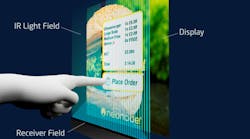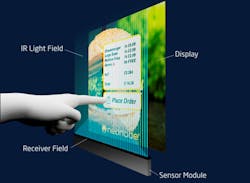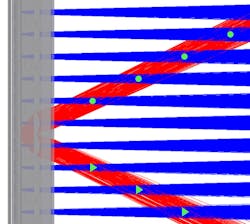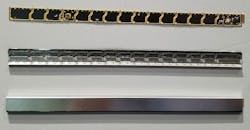Touch controls have become ubiquitous with the advent of smartphones. These days, the average child will try to operate something by touching or swiping since they’re accustomed to tablets and even laptops that have capacitive touch support. Capacitive touch technology works in many instances, but it’s not always the right solution. It also has limitations that can be addressed by competing solutions.
Optical sensing systems have the advantage of being able to detect any object, so it doesn’t matter whether a finger is encased in a glove, is wet or dirty, or if the object is something like a stick. The object just can’t be transparent. The usual implementation places a set of infrared emitters along two adjacent sides of a rectangular area like a display screen. Infrared sensors are placed along the other two sides. The X and Y coordinates are obtained by detecting where light is occluded.
Neonode’s zForce solution (Fig. 1) goes a slightly different route, using the same general type of emitters and sensors but taking reflectivity into account. That, along with a little triangulation, delivers the position of an object within its detection space that’s essentially a rectangular area in front of the sensor module. The module can be mounted on any side of the sensing area that doesn’t have to include a display. Feedback for the touch area can be provided by a variety of means, from audio or lighting to mechanical movements.
1. Neonode’s zForce solution uses a single sensor module mounted along the edge or a surface such as a display to detect objects like fingers.
The system’s emitters send infrared light straight out from the bar (Fig. 2). The sensors are angled so they can detect reflections across the area. Overlapping sensing provides redundancy and improves accuracy. The system is designed to track a single touch, although it’s possible to detect more.
2. The zForce system leverage triangulation to determine the location of an object. The infrared light (shown in blue) is generated by a row of emitters. The infrared sensors can detect reflections in the red area. Multiple, overlapping sensor regions make it possible to determine the position of an object.
The bars (Fig. 3) are available in different lengths. The controller has a USB interface that can also provide power. Versions are available in which the light guides are parallel or perpendicular to the edge.
3. The zForce bar is constructed from a circuit board (top) with the logic, emitters and sensors; a plastic optical wave guide (middle); and a protective cover (bottom).
Most applications will mount the sensor so that it’s on or close to a surface, but it’s not a requirement. The sensor could be used over an opening such as a shelf since it’s essentially a light curtain. The possibilities are actually more interesting than a touchscreen, which is more limited in configuration. In fact, the zForce sensor is often used with high-resolution screens where an additional layer needed for capacitive touch may not be desirable, such as in medical applications that can’t afford even small optical deviations.




